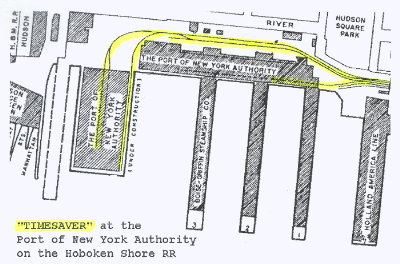| Here are a
few visual impressions of the Hoboken
Shore, from top to bottom: A GE 44-ton switcher
enters the floatbridge yard, where the
Empire State building in the background
definitely helps to set the locale.
(Picture ©
1974 Jay Mikesh / Click to enlarge)
Parked cars on both
sides of the track add to the overall
tight clerances.
(Picture ©
1974 Jay Mikesh / Click to enlarge)
An NMRA
excursion was organized on the Hoboken in
1964 using a GE 44-ton switcher and
gondolas. The floatbridge was the
Hoboken's interchange point with the
DL&W.
(Picture ©
1964 Richard Taylor / Click to enlarge)
Note also
the covered tracks sin some places.
(Picture ©
1964 Richard Taylor / Click to enlarge)
The Hoboken also
features an example of a prototype
Timesaver location, to be found at the
Port of New York Authority, where the
Hoboken's tracks run in a configuration
which even reflects the linearity of John
Allen's design to a certain degree.

|








